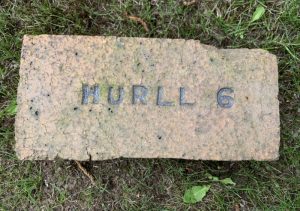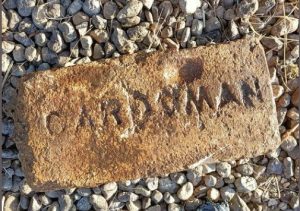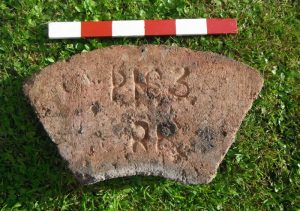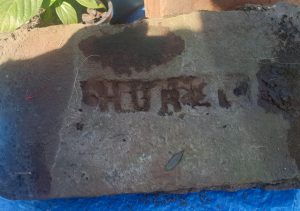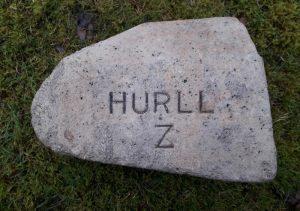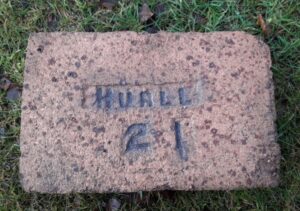Cardowan and Heathfield Works. The first of these works, belonging to Messrs. John Young and Son, was built in 1852 by Messrs. John Hurll and John Young, previous to that time of the Garnkirk Company. The clay is the Garnkirk seam and is of much the same character as the Stourbridge clay. The Heathfield Works were acquired about 1860 from Messrs. Miller and Ferguson and were largely extended and altered, and improved machinery was introduced. The clay was won at 350 feet, passing through a solid bed of freestone of 120 feet, giving off much water; the seam itself is known as the Glenboig seam of clay, as it was first wrought at the ” Glenboig Works,” with which Mr Young was also till quite recently, a partner. At the “Cardowan Works” the firm manufacture the usual varieties of fire bricks, blast-furnace blocks, gas retorts and fittings, vases, garden edgings, and plain and ornamental chimney shafts. At the ” Heathfield Works,” they produce fire-bricks, and vitrified salt-glazed pipes for sewerage and water purposes, and invert sewer blocks and all the usual salt-glazed articles. In 1874 Messrs. Hurll and Young dissolved the partnership; Mr Young, along with his sons John and Robert, being now the sole proprietors. The product of these works when in full work is about 20,000 fire bricks per day and about 1,500 yards of pipes weekly.
**********************
‘Garnkirk Fireclay by G Quail’ – Heathfield – Adjacent to Mark Sprot’s extensive fireclay deposits of Garnkirk were others owned by Dr James Jeffray of Cardowan, Professor of Anatomy at Glasgow University for the very long period 1790-1848. In 1832 Professor Jeffray’s fireclay bricks were said to be “not let”, but soon afterwards a fireclay works was established at Heathfield by Peter Ferguson to make use of these minerals. By 1834 Ferguson had a store at the Garnkirk & Glasgow Railway terminus at Townhead, Glasgow, for his Heathfield firebricks and tiles. About 1846 the Heathfield’s firm’s name was changed from Peter Ferguson & Co. to Ferguson, Miller & Co.
During the early years, the firm advertised only firebricks and tiles, but by 1852 the range was extended to include ornamental vases, chimney cans, flower pots, gas retorts, “furnishings of every description”, salt glaze, cane and Rockingham ware, “including every variety of pipes for the conveyance of water, and sanitary purposes-from one inch to eighteen inches diameter”, as well as firebricks and tiles. The following display was mounted at the great exhibition of 1851, in London:
Copy of Warwick vase, in fire clay, with pedestal. Exhibition vase, in fire clay, with pedestal. Ornamental flower vase, with pedestal. Specimens of ornamental chimney cans, in fire clay. Variety of small models in fire clay. Specimens of glazed stoneware pipes.
For this display, the Terra-cottas” jury awarded Ferguson, Miller & Co. a prize medal, appending this interesting comment:
“To Messrs Ferguson, Miller and Co … a Prize Medal has been awarded for sundry goods in terra-cotta, manufactured by them of fire-clay, and burnt at a high heat. The fire-clays found in various parts of the coal measures are now much used for different purposes where refractory clay is required, and amongst the rest for ornamental vases, and figures for outside decoration in gardens, for which they form a good artificial stone, much superior to common stone. The contraction that takes place in firing renders it somewhat difficult to model them with sufficient accuracy to ensure a satisfactory result, and this is especially the case where the form required is complicated and cut up into detail. The present exhibitors have prepared some vases expressly for the Exhibition, and they have shown ingenuity in adapting the design to the material”
During the second half of the nineteenth century, Heathfield Works passed through several changes of ownership. About 1862 it was taken over by Hurll, Young & Co. Of Cardowan Fireclay Works. In 1873, Young John, Sons &, Co partnership was dissolved. John Hurll moved to Glenboig to concentrate on his interests there, while John Young established the firm of John Young & Sons to take charge of Heathfield and Cardowan. This firm, in turn, went into liquidation during the late 1800s (Note – SBH – 1888 from other information on this page) and the works were purchased by John Faill of A. & J. Faill, contractors & quarry masters, Glasgow. Trading continued under the style of “Heathfield & Cardowan Fire Clay Co.” and the works were considerably extended.
The firm continued operations at Heathfield Works for a large part of the twentieth century. By the mid-1960s, when 90-100 men were employed, production was largely confined to sewerage pipes. A speciality was made of large pipes, 15 in, 18 in, 21 in and 24 in. diameter. Fireclay was still obtained from a mine in the immediate vicinity of the works, where six workers each cut about 3-5 tons of clay per day, using Kango hammers. This was loaded into hutches which were drawn on rails by a wire rope up a sloping shaft to the surface. In 1965 Mr George Cleland, a former manager of the works, felt confident to make the following statement:
The clay is very suitable for large sewage pipes which are of a very high standard. A large field of this clay is still available and is expected to last for many years … So the position is that Heathfield Works alone can look forward to the future with confidence, in the whole of that district so rich in Fire Clay 130 years ago.
His optimism was sadly misplaced. By the end of the same decade, the firm was in liquidation and the works closed down.
Despite the Great Exhibition prize medal, Heathfield does not seem to have developed to any great extent as a manufactory for ornamental fireclay ware. According to one account, the moulds for the Heathfield vases passed to the Garnkirk Company when the former works were taken over by Hurll, Young & Co. This has led to some confusion about the origin of specimens of these designs. During the period of ownership of John Young & Sons, there is evidence to suggest that any orders for industrial and utilitarian products. Photographs among the papers of George Cleland, however, suggest that ornamental ware was manufactured, at least to a limited extent, at Heathfield during the early twentieth century (after the closure of Cardowan). During the mid-1960s many moulds for balusters and vases of the Victorian era were still in existence at Heathfield, some of them used to fulfil the occasional order.
**********************
Heathfield Fireclay Works – This should be read in conjunction with the Cardowan Fireclay Company post.
Manufacturer(s): Peter Ferguson & Company (ca 1832-1845).
Ferguson, Miller & Company (ca 1845-1862) Robert Miller, Peter Ferguson (died 1855) and John Ferguson.
Hurll, Young & Company (ca 1862-1873).
John Young & Sons (ca 1873-1880).
Heathfield & Cardowan Fire Clay Company, Limited (ca 1880-1970).
Offices: 52 Robertson Street (1901-1918), 146 West Regent Street (1921-1936), 141 West George Street (1937-1963) Glasgow, Scotland.
Works: Heathfield, Cardowan, and Glasgow fire clay works, Garnkirk, Scotland.
Dates: ca. 1832 – 1970
The Heathfield site was continuously worked until 1970. Works noted as being mostly demolished by 1979.
Heathfield & Cardowan Fireclay Co., Ltd., Silica, and fire brick, gas retort, and sewerage pipe manufacturers; works, Heathfield and Cardowan, Near Garnkirk; offices, 141 West George St. C.2; Tel. No., Central 2537.
Heathfield Works, Lanarkshire – Ferguson, Miller & Co, Firebrick manufacturers, Moodiesburn.
Canmore
Below – 26/11/1832 – The Glasgow Herald – Heathfield Firebrick Works – an early reference.
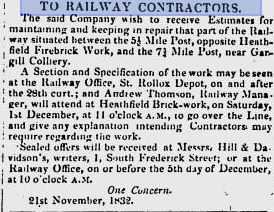
1834 – ‘Garnkirk Fireclay by G Quail’ – … By 1834 Ferguson had a store at the Garnkirk & Glasgow Railway terminus at Townhead, Glasgow for his Heathfield firebricks and tiles …
1835 – 1836 – Peter Ferguson Fire Brick and Tile Works, Heathfield, Store Railway Depot. Letters left at J Ferguson’s 70 Hutcheson Street.
1836 – 37 – Peter Ferguson Fire Brick and Tile Works, Heathfield, Store Railway Depot. Letters left at J Ferguson’s 70 Hutcheson Street.
1840 – 1841 – Peter Ferguson, Fire Brick and Tile Works, Heathfield. Store Railway Depot. Orders left at J. Ferguson’s 70 Hutcheson St. House Villafield Place.
1841 – 1842 – Peter Ferguson, Fire Brick and Tile Works, Heathfield, Store Railway depot. Orders left at J. Ferguson’s, 17 Gordon St. Ho. Villafield Pl. p.88.
1843 – 1844 – Peter Ferguson, Brick and Tile Works, Heathfield, Store Railway Depot. Orders left at J. Ferguson 125 Buchanan Street, Glasgow.
c. 1846 – The Heathfield’s firm’s name was changed from Peter Ferguson & Co. to Ferguson, Miller & Co.
1849 – 1850 – Ferguson & Miller & Co, brick and tile works, Heathfield Store, Garnkirk Railway Depot. Orders left at the Sun Fire Office, 125 Buchannan Street.
02/08/1850 – Glasgow Herald – Highland and Agricultural Society’s Grand Show in Glasgow – The Garnkirk Works have also sent in their quota of articles for exhibition. Here we find vases, modelled in the finest style of the art; busts of Watt and Henry Bell, executed with surprising accuracy and taste; ornamental chimney cans, &c; and, what is perhaps in most germane to the grand object of the exhibition, specimens of all sizes of salt-glazed pipes, both for drainage and general purposes. Ferguson and Miller, Heathfield Works, have also a numerous selection of articles of the same description, including a magnificent Warwick vase, the execution and modelling of which reflect great credit on the taste and skill of the designer.
05/08/1850 – Glasgow Herald – Highland and Agricultural Society’s Grand Show in Glasgow … We may add by way of appendix that, on Thursday, there were exhibited amongst the implements, specimens of glazed socketed pipes for conveying water by Mr Cairns, Messrs Ferguson, Miller & Co and Port-Dundas Pottery Company which gave great satisfaction and were expressly ordered on the ground. The former gentlemen exhibited a beautiful pedestal and vase of the same material. We were exceedingly gratified with the taste and artistic skill displayed both in the formation and arrangement of an assortment of magnificent fire clay vases embracing various designs and particularly with the centre one designed on the model of the well known Warwick vase of the most gorgeous and ingenious workmanship and forming together a nucleus of surpassing grandeur, all manufactured by Messrs Ferguson Miller & Co of the Heathfield Fire Brick and Pottery Works. It was at the special desire of the committee of management that this variegated selection was placed in front of the ladies gallery and which certainly added a feature of much interest to that portion of the exhibition. We also noticed that the same firm had a collection of chimney cans of various patterns as well as specimens of balusters and many other articles of the same material, all beautifully executed. Messrs Ferguson Miller & Co were successful in obtaining the prizes awarded for glazed water pipes.
08/08/1850 – Stirling Observer – Highland and Agricultural Society’s Grand Show in Glasgow … For the best collection of glazed socketed pipes adapted for the conveyance of water, together with specification and specimens of the cement used in connecting them, 2 sovs, to Ferguson, Miller & Co, Glasgow.
10/08/ 1850 – Bucks Herald – Highland and Agricultural Show Glasgow … Conspicuous this year are the productions of the Heathfield and Grangemouth Brickworks, the latter of which, besides some fancy articles has sent a collection of glazed tile pipes of all shapes and sizes.
26/04/1851 – Liverpool Mail – Sailors home bazaar. The bazaar in aid of the funds of the Sailors Home has been in every way auspicious, and no doubt the amount realised will be fully equal to the expectations of the promoters of the fete … Device of flowers – The prize was awarded to James Tyrer, Es. Brewster, gardener. It was placed on a beautiful vase manufactured by Ferguson, Miller and Co, Heathfield.
18/10/1851 – Edinburgh Evening Courant – Great Exhibition – Crystal Palace – Prize – Ferguson, Miller & Co, Heathfield near Glasgow – vases in terracotta.
Below – 1852 – Advert Ferguson, Miller and Co.

19/05/1853 – Freemans Journal – Great industrial exhibition at Dublin … The large terra cotta fountain near Baron Marochetti’s statue of the Queen has been completed; the scaffolding was removed yesterday evening, and a trial of the fountain made when it was found to work most admirably, throwing up a graceful jet of water to the height of about ten feet. The fountain itself is 24 feet high, and is composed of four basins – the second supported by three half-nude figures; the third by three dolphins, and the fourth by three herons, finished with the lily of the Nile, from the top of which the water is projected. The manufacturers are Messrs. Ferguson, Miller, and Co., Heathfield Company, Glasgow, who prepared this beautiful article specially for the Dublin Exhibition. One feature in the manufacture of this fountain deserves to be particularly noticed. The second basin is six feet in diameter, and we understand is the largest single piece of terra cotta that has ever been manufactured – the sprinkage (shrinkage?) on this material during the process of manufacture rendering it extremely difficult to produce an article of such dimensions. So difficult indeed was this achievement, that it was not until after repeated failures that the present fountain was completed, otherwise it would have graced the great hall on the day of opening. We may observe in passing that Messrs Ferguson and Miller exhibit a very extensive and creditable collection of terra cotta vases and statues at the eastern end of the northern hall. In addition to the two large antique Irish crosses erected at the eastern entrance of the great nave, several additional crosses have been placed in the same part of the building, and deserve an attentive examination, illustrating, as they do, the ecclesiastical antiquities of Ireland …
21/09/1853 – The Advocate/Irish Journal … Dublin Exhibition – the most conspicuous objects are … Messrs Ferguson and Millers fountain, 24 feet in height, is really a noble work. It was made at the Heathfield Works near Glasgow from the general design of Messrs Baird and Thomson, the architects, the figures being by Mossman, a Glasgow sculptor, and the ornaments by Mr J Steel.
1857 – Heathfield Works, Lanark. Ferguson Miller & Co, Manufacturers, Moodiesburn.
1858 – Mineral Statistics of the United Kingdom of Great Britain and Ireland for 1858 – Heathfield, clay of coal measures. Name of freeholder – Dr Jeffrey. Manufacturer – Ferguson, Miller & Co. Manufacture – Bricks, covers, flooring tiles, blocks, vases, cans, pipes &c. Estimated 9,000 tons annually.
1858 – 1859 – Ferguson, Miller and Co. Firebrick and stoneware pipes makers, Heathfield. Office 206 Buchanan Street, Glasgow. (P103).
Below – 1858 – Heathfield Fireclay Works.
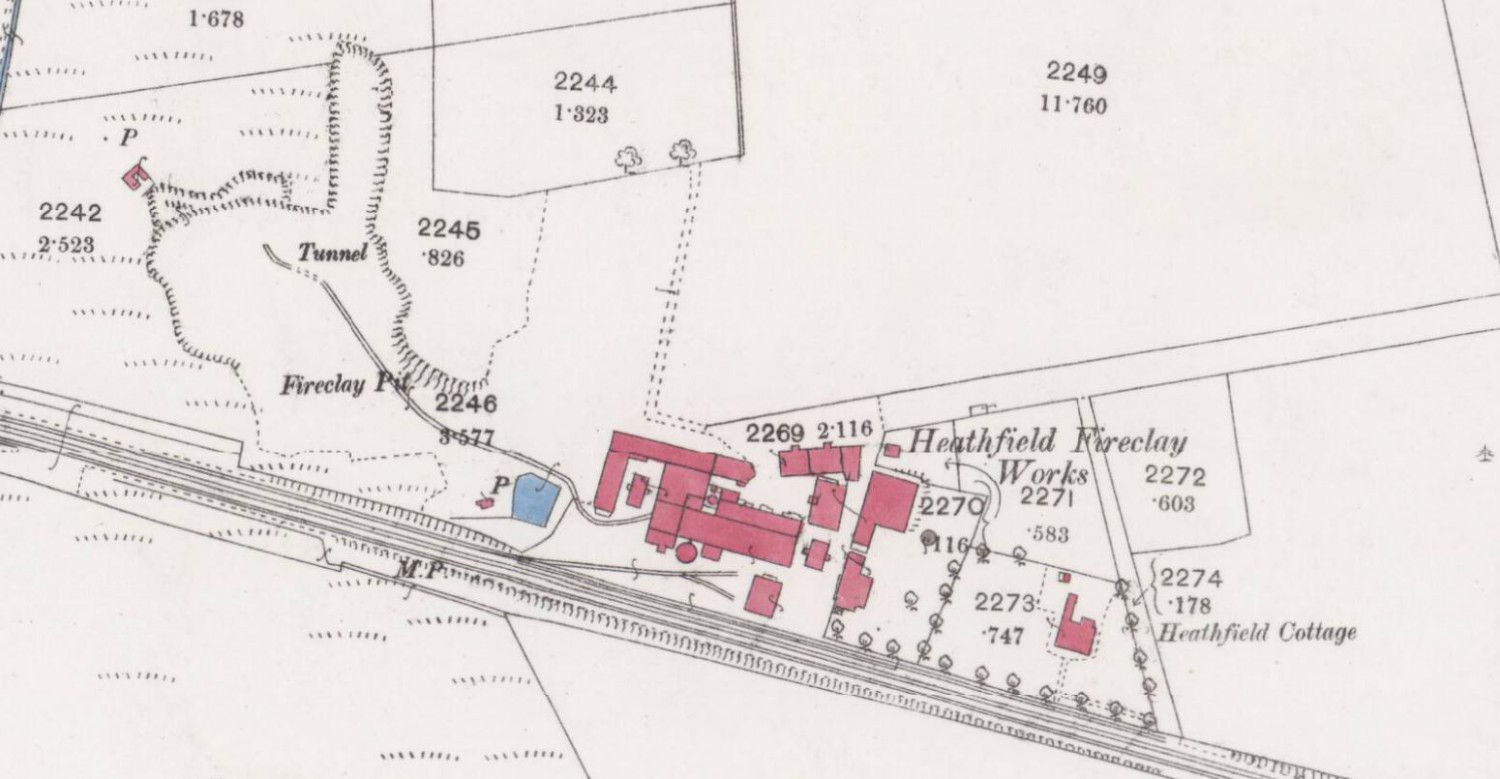
09/06/1858 – Glasgow Herald – A man engulfed for a hundred and eight hours. At Heathfield Fireclay Works, near Garnkirk, last Wednesday, at 12 o’clock midnight, James Templeton, one of the men employed in pumping water in the clay mine, observed, before leaving for supper, part of the debris of the superincumbent mass oozing from the roof of an old working at some distance from the place at which he had been engaged. This circumstance he mentioned to his relatives when he got home. His friends endeavoured to persuade him not to return; but he refused to listen to their remonstrance, remarking that “the break-down was far from the place where he worked, and even if there was a fall, he had an out gate.” Accordingly, he returned to his work, and early on Thursday morning, when the miners arrived they found that a “sit” had taken place and that the working had been entirely filled up by the entrance of the mass, which was a peculiarly soft and quick nature. they at once discovered that the unfortunate Templeton Millar, the proprietors of the works, on hearing of the occurrence, immediately ordered relays of workmen, who worked continuously in the endeavour to recover the unfortunate man. After the most indefatigable and well-directed efforts for a period of 180 hours, they succeeded on Monday afternoon in finding their fellow-workman, to their astonishment, and, we may add, joy, still alive, though much exhausted. Dr Oliver, who was in attendance, promptly and skilfully administered the necessary restorative, and we are happy to state that the sufferer is progressing favourably, and there is every prospect that he will be completely restored to his wanted health in a few days. Templeton is a powerful, sinewy man, about thirty-six years of age. It will be remembered that only three weeks have elapsed since three men were buried alive in a neighbouring clay pit, who were recovered after having been fifty-nine hours enclosed in the bowels of the earth. They are now well. Templeton’s case, however, is much more remarkable not altogether unprecedented. he is not yet able to give a connected account of his sensations and sufferings during the dreary entombment, but he states that he endeavoured to keep the calculation of the time by feeling the hands of his watch.
18/11/1859 – Liverpool Mercury – Heathfield Terra Cotta Works. Messrs Ferguson, Miller and Co desire to express their thanks for the ample share of public patronage which they have enjoyed and respectfully to call attention to their manufactures in windguards and chimney tops are of such design as to harmonise with the most elegant and classical styles of architecture and also to their varied stock of vases, garden borders, drain pipes etc. All orders addressed to their agent, Mr Adam Gibson, 23 and 25 Suffolk Street, Liverpool will receive immediate attention.
Below – 28/09/1860 – Belfast Morning News. Ferguson Miller & Co, Terra Cotta Fire Clay Works.

Below – 1861 – Advert Ferguson and Miller Heathfield Glasgow.
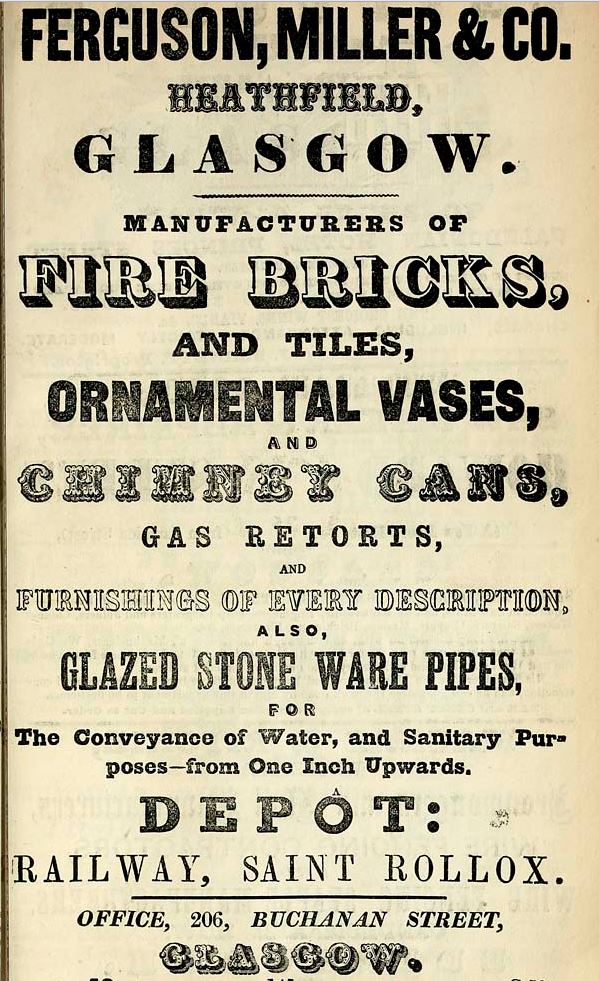
Below – 06/08/1861 – Belfast Morning News – Advert. James McWade, Ballymacarrett, Belfast. Sole agent in Northern Ireland for fire clay goods manufactured by Ferguson, Miller and Co.

29/03/1862 and 28/05/1862 – Glasgow Morning Journal – Heathfield Brickworks for sale – To be sold by public roup within the Faculty Hall, St Georges Place, Glasgow on Wednesday 28th May 1862 at 1 o’clock at the upset price of £3500. All and whole that piece of ground consisting of 2 acres, 1 rood and 30 poles imperial measure, part of the Lands of Baads lying in the Parish of Cadder and County of Lanark as the said piece of ground in particular described in the title deeds thereof, together with the whole buildings and machinery thereon, including the steam engines and grinding mills, conform to the articles of roup. The Heathfield Brickworks are situated within 200 yards of the Garnkirk Station of the Caledonian Railway and have been occupied for many years by Ferguson, Miller and Company. The landlord is willing to grant a lease of the Fire Clay to the purchaser on the same terms as the formerly held Messers Ferguson, Miller and Company with some trifling alterations. The quality of the fire clay is well known in the Glasgow market as very superior and the Works are at present in operation. For particulars apply to John Jeffray, Writer, 193 Vincent Street, Glasgow or to Mr William McCreath, Mining Engineer, 112 West George Street, Glasgow or Drumpark by Coatbridge. 07/05/1862. (Note – SBH – ‘Garnkirk Fireclay by G Quail’ … The Heathfield Fire Clay Works were taken over by Hurll, Young & Co around 1862).
11/08/1862 – Dundee Advertiser and 06/09/1862 – Glasgow Morning Journal – In the sequestration of Ferguson, Miller & Co, manufacturers of fire bricks and stoneware pipes etc, Heathfield Works, in the Parish of Cadder and county of Lanark, and John Ferguson, manufacturer of fire bricks and stoneware pipes etc, Heathfield aforesaid, lately residing there and now manager, Llwynenion Works, Ruabon, Denbighshire (Llwyneinion)and residing there and Robert Miller, manufacturer of fire bricks and stoneware pipes etc, Heathfield aforesaid and residing there, the individual partners of that company, as partners thereof, and as individuals.
Present Mr W.G.Lindsay, accountant, trustee; and Mr Archibald Ferguson, Writer, law agent in the sequestration.
Robert Miller one of the bankrupts deponed – I commenced business at Heathfield in 1845 in company with John Ferguson, my present partner and the late Mr Peter Ferguson, under the firm of Ferguson, Miller & Co. My department of the business consisted in attending to the counting-house, keeping the books and making sales. I contributed £250 as my share of the capital of the concern and the workable plant and machinery at the works was to be held as the share of the other partners. The works at the time of the partnership were formed were on a comparatively small scale. They were afterwards extended very considerably by the firm at the outlay of several thousand pounds. Mr Peter Ferguson died prior to our stoppage in 1855. The works were rented by the company from the late Mr John Ferguson, sen, as trustee, as I understand, for the late Mr Peter Ferguson, the father of the partner at a yearly rent of £250. After the firm stopped in 1855, we effected a private settlement with the creditors, for 5s in the pound and after this John Ferguson and I continued to carry on the works under the old firm.
I am now shown a statement of the company’s affairs. exhibiting liabilities to the amount of £6186 16s 5d, and assets to the amount of £471 14s 4d showing a deficiency of £5715 2s 1d. There was a balance in favour of the company, as shown by the balance taken in 1857 of £1690 13s 4d and I account for the deficiency and the loss of this balance since 1857 by a loss in conducting the business of £2253 3s 3d which comprehends what was sunk in the improvements of the works since January 1858; by old debts paid in full £880 18s 4d; by loss on consignments of sewage pipes to New York, £2565 9s 4d; loss of bad debts £1170 9s 9d; revised debts now ranking £350; accommodation and other bills ranked for, for which our firm got no value, £200; debts of John Ferguson jun, assumed by the firm, £67.
The bankrupt John Ferguson was afterwards examined and corroborated the statements previously made by his partner. This concluded the examination.
Below – Feb 1963 – Refractory Journal – Loudon and Russell and the Heathfield and Cardowan Fireclay Company supplying fireclay to Ravenscraig. Members of the ‘National Salt Glazed Pipe Manufacturers Association’.

25/07/1863 – Daily Review Edinburgh – Dividends … Creditors of Ferguson, Miller & Co, manufacturers of fire bricks and stoneware pipes &c, Heathfield Works in the Parish of Cadder and County of Lanark will receive a dividend at the chambers of W. G & J. W. Lindsay, accountants, 110 Buchanan Street, Glasgow on or after Monday 7th September. Wm G Lindsay, trustee.
20/05/1864 – Glasgow Herald – James Merrie, contractor, Heathfield Brickworks pays David Gillespie and William McConnell or any of his men, daily or hourly if required.
Below – 02/03/1865 – Inverness Courier – Heathfield and Cardowan Fire Brick and Sewerage Pipe Works near Garnkirk. Advert Hurll, Young & Co.

1868 – Young and Co, Heathfield Brickworks, Moodiesburn, Glasgow.
04/05/1868 – Glasgow Evening Citizen – Justice of the Peace Court. A ‘candyman’ in trouble. Lawrence McGill, hawker, Shettleston, was sent 60 days to prison for having resetted four cast-iron wheels that had been stolen from Heathfield Fire Clay Works by three children. It appeared that he had given the children sweeties and candy for the wheels.
1869 – John Young & Sons Co. (fire bricks) brands, Cardowan & Young’s, for chemical, glass, iron & copper roasting furnaces, the Siemens-Martin steel and every other description of a furnace where excessive heat is required; gas retorts, chimney cans, glazed sewerage pipes, &c. (Illustrated sheets on application) ; office, 42 Bath St; works, Heathfield and Cardowan, near Coatbridge.
1870 – Invoices – Hurll, Young & Co, Heathfield and Cardowan Fire Brick Works near Garnkirk. Office 188 Buchanan St, Glasgow. Deport St Rollox. Manufacturers of sewerage pipes, fire bricks, gas retorts, ornamental chimney cans, flue covers, paving tiles &c.
1873 – ‘Garnkirk Fireclay by G Quail’ – The Hurll, Young & Co partnership was dissolved. John Hurll moved to Glenboig to concentrate his interests there while John Young established the firm of John Young and Sons to take charge of Heathfield and Cardowan …
20/02/1874 – Glasgow Herald – Glasgow, 18th February 1874. The copartnery concern of Hurll, Young & Company, coalmasters and sewage pipe and fire brick manufacturers, here, and at Drumgray, Heathfield and Cardowan, of which the subscribers were the sole partners has been dissolved by mutual consent as on 29th November last. The subscriber Mr Youn, who continues the business, is authorised to receive and discharge all debts due to and he will pay all debts due by, the dissolved company. John Hurll and John Young …
Below – 1875 – Advert – John Young and Sons, Heathfield and Cardowan.

22/02/1875 – Belfast Telegraph – Supposed suicide of boy. The dead body Wm. John Livingstone, twelve years of age, and son of John Livingstone, labourer, Heathfield, Parish of Cadder was lying on the Caledonian Railway at the Heathfield Fire-Clay Works, near Garnkirk Station. He had been employed at these works but on Thursday night he told his mother that had been dismissed for smoking on the premises. About eight o’clock that evening he was out for water to a pond near the house, but not returning, his father went to ascertain what had caused the delay The pails were found empty on the edge of the pond, but the boy was not be seen, and on search being instituted the body was found on the rails. The deceased had been killed by a train.
1880 – 1882 – Invoice – Various invoices. John Young & Sons, Heathfield and Cardowan Fire Brick Works near Garnkirk. Office 188 Buchanan St, Glasgow. Deport St Rollox. Manufacturers of sewerage pipes, fire bricks, gas retorts, ornamental chimney cans, flue covers, paving tiles &c.
09/03/1880 – Glasgow Evening Citizen – Found at Heathfield Fire Clay Works a black retriever dog. Owner can have it by proving property and paying expenses. Apply to the joiner, Heathfield.
1882 – John Young & Sons. Firebricks brands – Cardowan and Young’s Glenboig for chemical, glass, iron and copper roasting furnaces, the Siemens-Martin steel and every other description of a furnace where excessive heat is required; gas retorts, chimney cans, glazed sewerage pipes, &c. (Illustrated sheets on application). Offices 188 Buchannan Street.
1882 – John Young, fire brick maker (John Young & Sons) Easter House, Ballieston.
Robert Young, fire brick manufacturer (John Young & Sons) Whitehill Villa, Stepps.
John Young junior, fire brick maker ( John Young & Sons) Easter House, Ballieston.
1882 – John Young & Sons – Heathfield and Cardowan.
1882 – John Young & Sons. Firebricks brands – Cardowan and Young’s Glenboig for chemical, glass, iron and copper roasting furnaces, the Siemens-Martin steel and every other description of a furnace where excessive heat is required; gas retorts, chimney cans, glazed sewerage pipes, &c. (Illustrated sheets on application). Offices 188 Buchannan Street.
05/02/1883 – Glasgow Herald – James Dunnachie and others V John Young & Sons. The complainers here are the proprietors of the Star Fire-Brick Works, Glenboig, near Coatbridge, and the Glenboig Fire-Clay Company, Glenboig, and they sought to interdict the respondents, who are sewage-pipes and fire-clay goods manufacturers, Heathfield and Cardowan, Lanarkshire, from selling, shipping, or exporting any fire-clay goods stamped with the word Glenboig other than fire-clay goods manufactured by the complainers. They state that the clay obtained in the Glenboig seam, which is co-extensive with the farm of Glenboig, is of superior quality, that it is especially valuable in the market, that it belongs to and is marked by them; and that the respondents have been making and selling goods under the name of Glenboig with the view of deceiving purchasers. Last year the Lord Ordinary on the bills granted interim interdict and ordered answers. In these the respondents say that they own and work the clay of the Glenboig seam; that the clay is identical in quality through the whole extent of the seam, extending beyond Glenboig Farm; that the goods made a from it are known as Glenboig goods by whom-so- ever made, and that the term is not confined to goods made by the complainers. In addition, they maintain that the trade and the public have long known that they made goods from the Glenboig seam and sold such goods as Glenboig and further, that it was a recognised custom that all goods manufactured from a particular seam should be so described, no matter who made them. Evidence was led at considerable length a fortnight ago, and today decision was given in favour of the respondents. The Lord Ordinary said that there were two things which the interdict was intended to strike at – first, the imitation of the trademark of both or either of the complainers; and, second, the use of the name “Glenboig” at all, not merely as a trademark in the proper sense, that was, as a distinctive mark impressed upon the respondents’ goods, or affixed as a distinctive word in catalogues, advertisements, or in any other way to designate goods manufactured and sold by them, and that irrespective altogether of the meaning that they may take to inform their customers or the public that they are not goods manufactured by either of the complainers. The second of these claims was pressed by the Solicitor-General, who stated that certain circulars and advertisements which the respondents had been in the habit of issuing for many years without complaint could not have been effectively challenged although they fell within the terms of the interdict now asked. His Lordship did not now understand it to be maintained that the complainers had acquired such an absolute and exclusive right in the use of the word Glenboig that they were entitled to prevent another manufacturer employing it as a distinctive of fire-clay goods which were not themselves marked with it, even though he did so in a way neither calculated nor intended to deceive. Nor was it intelligible that such an exclusive right to the use of a distinctive name should be vested at the same time in two independent and competing manufacturers. The question requiring consideration, therefore, appeared to his Lordship to be whether the complainers were entitled to interdicts in the terms asked against the use of the word “Glenboig” by the respondents a trademark, or against his use of that word in combination with another word or words because it was perfectly clear that the use of the word “Glenboig” by itself would be a direct invasion of the Glenboig Company’s right. The two complainers are tenants of portions of a bed of clay lying under the lands of Glenboig, and each of them has works situated upon the lands. Their averment and it was entirely borne out by the evidence, was that the clay on the Glenboig Farm possessed many exceptional qualities, and was described as possessing to a larger extent than other fire-clays the power of resisting heat at high temperatures, and in particular that the goods made from it are free from the risk of cracking after being subjected to an extreme heat. This was a most valuable quality in fire-clay goods. And then the complainers went on to say that the goods manufactured by them had acquired a favourable reputation in districts where they were used, as Glenboig goods. Each of the complainers is the registered proprietor of a trademark which they impress upon the goods manufactured by them. The Glenboigs Company’s mark consisted of the word ‘Glenboig’ alone, while Messrs Dunnachie’s mark is a device consisting of the words ‘Star Works, Glenboig’ with a star and the initials ‘J D’ between these two letters. The complainers said, and they quite clearly proved, that these two words, ‘Glenboig’ and ‘Glenboig’ Star’ had established a reputation for excellence, and commanded a high price both, in the home and foreign markets. There could be no doubt that the complainers’ goods were in great demand and had a fair reputation both in this country and on the continent, and that reputation, which was proved to be well merited, was of great commercial value. There could be as little doubt that this high reputation was attributable not to any peculiarity or special excellence in the manufacture, but to the distinct qualities of the Glenboig clay. It was not disputed that the complainers are excellent manufacturers and that they would not have acquired a reputation for their fire-clay goods had they not been well and carefully made, but at the same time there was nothing exceptional in their process, and if the same material had been wrought by another competent manufacturer his goods must have obtained the same currency and demand as those of the complainers. Without going into details, his Lordship was of opinion that the respondents, who are the lessees of a fire-clay field in the immediate neighbourhood of the complainers, began about eight years ago to work a seam identically good in quality to the seams worked by the complainer. It was, in his opinion, perfectly immaterial to consider whether there was uninterrupted continuity of a strata between the mineral field worked by complainers and the mineral field worked by the respondents. For all practical purposes, they were working the same seam, and his Lordship thought it had been proved that before the respondents reached that seam it was known among engineers and fire-clay manufacturers to extend beyond the limits of the area leased by the complainers and that both within and beyond that area it was known by the name of Glenboig clay, and by no other name. Now it appeared to his Lordship that as soon as the respondents had reached Glenboig clay and had begun to work it they were in entitled to take advantage, not of the complainer’s reputation as manufacturers, but of the reputation of the valuable raw material which they had ra acquired and accordingly it was hardly disputed in the argument that they were justified in issuing circulars in 1874 stating that they were engaged sinking a pit to the fire-clay known as the Glenboig seam. From that time downwards they had constantly advertised in various forms that they were manufacturing bricks from the clay known as Glenboig. That had been done without challenge from any of the complainers. Assuming these proceedings to be within the respondent’s rights, it was of course clear that they were not entitled to imitate the trademark of the complainers or in any other way to represent that the goods they sold were goods manufactured by the complainers. The complaint was that the respondents proposed to brand their bricks with the words ‘Young’s Glenboig’ and this was said to be a mere colourable imitation of the trademarks of the complainers. But neither of the complainers, in His Lordship’s opinion, was in a position to maintain that the use of the word “Glenboig,’ although accompanied by a distinct variation, was in itself an infringement of his trademark, because each of them as against the other had a right to the use of that word. They were competing against each other in the home and foreign markets, which conceded a right which in this action they both denied to the respondents. The only question, therefore, appeared to be whether the variation which had been adopted by the respondents was sufficiently distinctive. In his Lordship’s opinion the brand ‘Young’s Glenboig’ was just as distinguishable from Mr Hurll’s ‘Glenboig’ and Mr Dunnachies ‘Star Glenboig’ as either of these was from the other. There had been a great deal of evidence on this point, but it had been entirely in accordance with the conclusion that His Lordship had arrived at, that the brand ‘Young’s Glenboig’ could deceive nobody. But it had been said that in Russia and Germany it would be different. If it were so it might be a question how far that which was otherwise an ordinary bona fide trademark, used by a trader in this country, and unimpeachable here, could be prohibited and interdicted, merely because it was liable to lead to misapprehension in particular markets. There was no authority, so far as he knew, for that proposition. The marks being, names or words in the English language, they would be quite distinguishable wherever the words could be read and understood. On the whole, his Lordship was of opinion that the interim interdict formerly granted must be recalled, and the note of suspension refused, with expenses to the respondents …
23/05/1883 – Glasgow Herald – James Dunnachie and others V John Young & Sons -The complainers and reclaimers here are the proprietors of the Star Fire Brick Works, Glenboig, near Coatbridge and the Glenboig Fire Clay Company, Glenboig, and they sought to interdict the respondents, who are sewage pipes and fire-clay goods manufacturers, Heathfield and Cardowan, Lanarkshire from selling, shipping, or exporting any fire-clay goods stamped with the word Glenboig other than fire-clay goods manufactured by the complainers. There was a further conclusion in the prayer of the petition against the respondents advertising, for sale any goods as Glenboig goods other than those manufactured by the complainers, and also to prevent them, using the words objected to on invoices, memorandums, &c. The Lord Ordinary Kinnear after hearing evidence in the case issued an interlocutor finding in favour of the respondents, with expenses. A reclaiming note was presented against this decision, and upon it counsel were heard towards the end of the last session, and avizandum was then made. Today the Court decided the case.
The Lord Justice Clerk, who gave the leading opinion, said that two questions were raised in this case – first, whether the respondents had assumed and applied to articles manufactured by themselves the trade name in use to be applied by the complainers to articles manufactured by them, and that for the purpose of inducing purchasers to believe that such articles were manufactured by the complainers; and secondly and separately, whether the respondents had used arid applied to their own ware the registered trademark of the complainers. The relative position of the parties to this dispute, His Lordship said, might be very shortly described. Both were manufacturers of goods from fire-clay, their works being situated about two miles from each other, and they used in their manufacture the clay found in the lands on which these works were placed. The name of the lands on which the complainers works stood was Glenboig and that of those occupied by the respondents Heathfield. The same seam and quality of clay were found in each. It had been the invariable practice in this trade to name the ware manufactured at the different works by that of the lands which they occupied, and thus the manufacture of the complainants had been universally known in the trade as Glenboig, and that of the respondents as Heathfield and they passed under these denominations in the market, and the ware, had been stamped with these respective names. It appeared, however, that the Glenboig fire-clay had attained a reputation in the market which Heathfield had never reached, and hence this controversy. The superiority of Glenboig was attributed by Heathfield to the fact that the former used in the manufacture a seam of clay of fine quality, which, although existing on the Heathfield lands also, the respondents had not been fortunate enough or skilful enough to arrive at. At last, in 1874, their workings struck this seam; and not allowing the excellence of their ware to make it known to the trade, they had pursued a system of advertisement in order to publish the fact that they were working the same seam of clay as that found at Glenboig, until at last, in 1882 they began to stamp the Heathfield ware with the words ‘Young’s Glenboig’. The object of these proceedings was not disguised. The Heathfield ware had no connection whatever with the neighbouring works, any more than it had with the other fire-clay fields in the vicinity, where precisely the same seams of clay occur; and it would have been quite reasonable to have called these fire bricks by the name of Garnkirk, Gartcosh, or Cumbernauld, as to stamp them with the name of Glenboig. The object of the proceeding was to attract to Heathfield goods part of the popularity of Glenboig. But it was said that in stamping their ware with the word ‘Glenoboig’ the respondents did not mean the trade or the public to understand that these goods were made at Glenboig, but only that they were made out of a seam of clay which they alleged to be known as the Glenboig seam. If it were material to the question before the Court his Lordship thought the evidence brought to establish that the word ‘Glenboig’ was known as a generic name applicable to a particular seam of clay wherever found, was both untrustworthy and inconclusive. The perusal of it had satisfied His Lordship that until the respondents commenced their advertisements in 1874 there was nothing like a general or even a partial use of the name in this sense even among scientific men. But it was quite sufficient for the present purpose that the witnesses were all agreed that until 1882 the invariable practice in the trade was to name the fire-bricks after the name of the lands on which they were manufactured, and that none were even known to be named after a particular seam of fireclay. It followed from this universal custom that the name of Glenboig meant in the trade when applied to fire-bricks, those manufactured at the Glenboig Works, and was not understood or intended to mean anything else. His Lordship came to the conclusion, and with no hesitation that in stamping their goods with the words ‘Young’s Glenboig’ the respondents intended their customers to believe that they were manufactured at Glenboig and that because of the high reputation which that manufacture had attained in the trade. They could not mean their customers to believe that the word ‘Glenboig’ merely described the seam, because they knew that this was never done in the trade. On this part of the case, His Lordship said, he should desire no further evidence than that afforded by the immediate facts out of which this dispute had arisen. In 1882 the complainers received an order from a Glasgow firm for a large quantity of fire-brick. The complainers were too busy to undertake it, and they recommended the respondents to their customers. In the execution of this order, the respondents for the first time used the stamp ‘Youngs Glenboig’. The complainers immediately remonstrated, and Mr Young at once expressed his deep regret and said it had been done without his knowledge and that it was very wrong and should not happen again, and entreated the complainers to intercede with the Glasgow firm to accept the goods without the word ‘Glenboig’ stamped on them. But the Glasgow firm were obdurate. They wanted the stamp of Glenboig because their customers would accept no other, proving clearly that the trade attached no consequence whatever to the seam of clay from which they were manufactured and cared only for the stamp of the Glenboig manufactury. If this were so the addition of the word ” Youngs” was merely colourable. His Lordship was therefore entirely with the complainers on the first point and the second became immaterial. He was, however, of the opinion that the respondents had infringed or adopted the registered trademark of the complainers. But it had been contended that the respondents had not adopted the trademark, because ‘ “Young’s Glenboig'” was not the trademark. This contention appeared to His Lordship to be quite inadmissible. The respondents were not entitled to use the trademark and had no reasonable excuse for doing so and the addition of their own name would not justify them in adopting the trademark of their neighbour. It was said that Mr Dunnachie, who was also a manufacturer on the lands of Glenboig, had used without objection from the other respondents the trade name of ‘Star Glenboig’ and that, therefore, anyone who chose might adopt the trademark of the company if any other word were put before it. His Lordship could not see anything in this view, or any analogy between the cases. The ‘Star Glenboig’ ware was rightly and honestly so-called, unlike that of the respondents. It was Glenboig ware. The name expressed nothing but the truth, Whether the assumption of that designation would or would not have been an infringement of the other company’s trademark the court needed not to consider because it was not challenged. It did not follow that the trademark would have been acquired at all but for the acquiescence of the company in the modification thus introduced. His Lordship was, therefore, prepared to grant interdict prayed for in the first part of the prayer. In regard to the advertisements, although they were ambiguous and perhaps disingenuous, he was not prepared to say that they all constituted a violation of the complainer’s right. The respondents were entitled to say that their seam of clay was the same as that found in Glenboig, for that appeared to be true, but they were bound to make their meaning quite distinct and to use no word which could lead to the inference that the goods referred to were made at Glenboig. But the prayer of the petition was much too wide and he thought the complainers would be well advised if they confined their demands to interdict against stamping the goods and depart from the rest of the prayer. The other judges concurred in this opinion.
Mr Trayner for the complainers said that they accepted the suggestion of the bench and they did this all the more readily that they honestly believed that Messrs Young would be as glad to yield real obedience to the court as the complainers were to accept the suggestion.
A short discussion then took place on the question of expenses and the court on the grounds that the complainers had been substantially successful, gave them expenses …
(Note – SBH – The court found in favour of Mr Dunnachie and others and thus it would seem that the Young’s, Glenboig stamp was only used between 1882 and 1883. (assuming Mr Young ceased to use it after the court decision).
Below – 01/05/1884 – Clyde Bill of Entry and Shipping list – Advert. John Young and Sons, Heathfield and Cardowan Works near Coatbridge.

26/01/1885 – The Scotsman – Glenboig Union Fire Clay Company Limited V John Young & Son. Another court case brought about by the Heathfield works using the Glenboig trademark. Heathfield appears not to have adhered to the Court’s decision in 1883 that they were wrong to use the Glenboig name.

Below – 25/05/1887 – Clyde Bill of Entry and Shipping List. Advert. John Young and Sons, Heathfield and Cardowan Works near Coatbridge – Young’s Sillica (Silica).

Below – 28/09/1887 – Falkirk Herald – Farm at Heathfield to let including the ground occupied by the Heathfield Fire Clay Works and the fire clay pits and railway and the feus.

1887? – ‘Garnkirk Fireclay by G Quail’ – John Young & Sons went into liquidation in the late 1880s and the works were purchased by John Faill of A & J Faill, contractors and quarrymasters, Glasgow. Trading continued under the style of “Heathfield & Cardowan Fire Clay Co.” and the works were considerably extended …
05/09/1888 – Kirkintilloch Herald – The Heathfield and Cardowan Brickworks, which have been at a standstill for over 12 months, have again started operations.
Below – 1889 – Heathfield and Cardowan Fire Clay Co.

13/01/1890 – Glasgow Herald – John Young & Co V Heathfield and Cardowan Fire Clay Company. Lord Kincairney heard counsel in a note by John Young & Co, fire clay goods manufacturers, 42 Bath Street, Glasgow to interdict the Heathfield and Cardowan Fire Clay Company, 5 Dixon Street, Glasgow from selling fire clay bricks stamped with the name Cardowan other than goods manufactured by the complainers. In 1888 the respondents became tenants of the lands of Heathfield having purchased the business of John Young & Co from the trustees on the sequestrated estates of that firm. At the date of the sequestration, the fire clay in the lands of Cardowan in so far as let to them had been exhausted and the respondents on taking up the business issued a circular to their customers intimating that the brand on all bricks manufactured by them would in future be that of Heathfield. In July 1888, the complainers registered the words ‘Youngs’ and ‘Cardowan’ as their trademarks. Recently it came to the knowledge of the complainers that the respondents were stamping their goods with the same trademark as that used by the complainers, to the injury of the latters business. The respondents in their answers state that the fire clay in the lands of Cardowan never was exhausted by the sequestrated firm and that it was at present being worked by the respondents. The word ‘Cardowan’ had been used by John Young, Sons and Co in their business long before it was registered by the complainers. The word ‘Cardowan’ is a geographical term applicable to the works belonging to the respondents and the estates on which their works are situated and the complainers have no right or interest of any kind in any property or fire clay in connection with such works or estate. After hearing counsel, his Lordship passed the note for trial of the case…
11/06/1890 – Glasgow Herald – John Young & Co V Heathfield and Cardowan Fire Clay Company. A Proof was to have been led today in an action by John Young & Co., fire clay goods manufacturers, 42 Bath Street, Glasgow, to interdict the Heathfield and Cardowan Fire Clay Company, 5 Dixon Street, Glasgow, from selling fire clay bricks stamped with the name Cardowan other than goods manufactured by the complainers. In 1888 the respondents became tenants of the lands of Heathfield, having purchased the business of John Young, Sons & Co., from the trustee on the sequestrated estates of that firm. At the date of the sequestration the fire clay in the lands of Cardowan in as far as let to them had been exhausted, and the respondents on taking up the business issued a circular to their customers intimating that the brand on all bricks manufactured by then would in future be that of Heathfield. In July 1886, the complainers registered the words “Youngs” and “Cardowan” as their trademarks. Recently it came to the knowledge of the complainers that the respondents were stamping their goods with the same trademark as that used by the complainers, to the injury of the latter’s business. The respondents in their answers state that the fire-clay lands of Cardowan never was exhausted by the sequestrated firm and that it was at present being worked by the respondents. The word Cardowan had been used by John Young, Sons & Co. in their business long before it was registered by the complainers. The word Cardowan is a geographical term applicable to the works belonging to the respondents and the estate on which their works are situated and the complainers have no right or interest of any kind in any property, or in connection with such works or estate. When the proof was called today it was intimated that the action had been settled.
16/07/1890 – The Scotsman – John Young & Co V Heathfield and Cardowan Fire Clay Company. John Young & Co, fireclay goods manufacturers and merchants, 42 Bath Street, Glasgow, the registered proprietors of the trademark ‘Cardowan’ sought in this action to have the Heathfield and Cardowan Fireclay Company, Heathfield, Garnkirk, Lanarkshire and 5 Dixon Street, Glasgow, interdicted from using that trademark. In the other action, the Cardowan Company petitioned to have Young & Company’s name removed from the register of trademarks as owners of the ‘Cardowan’ trademark. Both actions have been taken out of Court, the Cardowan Company having purchased the trademark from Young & Co, each party paying their own expenses …
31/12/1890 – Kirkintilloch Herald – Chryston. The Sabbath schools in connection with the Parish Church had their usual Christmas treat the evening of Wednesday. Mr John Faill, of Heathfield and Cardowan works, occupied the chair. Addresses were delivered by the Chairman, the Rev. W. Davidson, and Mr Forsyth, Langrigg. Songs were sung by several of the teachers, and through the kindness of Mrs Finlayson, Garnkirk House, an abundance of creature comforts were provided for the children. A magic lantern entertainment was also given. The number of parents and children present was the largest that had ever attended the Christmas festival in the church. This, we believe, is owing to the accession of Heathfield Sunday school, recently opened by Mr Davidson, whose indefatigable exertions in that quarter are meeting with great success.
28/01/1891 – Glasgow Herald – Wanted to purchase. Triping and dross, various qualities. Apply Heathfield and Cardowan Fireclay Company. 52 Robertson Street.
08/03/1893 – Kirkintilloch Herald – The first social meeting of the employees of Heathfield and Cardowan Fireclay Works was held in the Drill Hall, Muirhead on the 28th … The Chairman said—My first duty tonight is to thank the gentlemen who have charge of the soiree for appointing me to the office of Chairman. With your forbearance and help, I will try to discharge its duties. I hope that our meeting tonight will be pleasant and profitable to us all and the forerunner of many such meetings in the future. (Applause.) This is then the first soiree of the Heathfield and Cardowan Fire Clay Works unitedly. Every new thing has an interest of its own, by reason of being new. It has no bygones and is therefore without a history. There is nothing to judge of it from. It has its basis on the existence of an industry that is two-fold, Heathfield and Cardowan and if employers and employed meet daily in the execution of work, they may meet yearly-in its relaxation and to the mutual interchange of the good offices of friendship, edification, entertainment and affection. (Applause.) A closer acquaintance may more fully cement our friendship and help to lessen the friction inseparable from the labour of our lives. The work of life has more of drudgery and hardship than is needful to its due performance or helpful to our enjoyment or highest well-being. Work, to save it from being oppressive, needs limitations, and from being tame and tiresome it needs relaxation and change. (Applause.) It is accepted as a settled matter that a social meeting of employers and employed should be an annual one. Meetings that have an interval of a year between cannot be said to be too frequent. In such a case, there is the stronger obligation that they should be interesting, entertaining and profitable. If we cannot have frequency, we should strive after excellence. Quality rather than quantity merits commendation. The committee under whose auspices all the arrangements have been made, claim for the present programme a character for excellence. It has variety and fulness in all the departments of entertainment. Our friends who have kindly favoured us with their presence and assistance, are numerous and varied, and from distant places, while larger attendance, growing out of an increased number of employees, give consequence and value to our meeting. Our daily meetings to the performance of our daily work is a necessity. We work to live, and we live in order to achieve a measure of usefulness and comfort. Work is not the whole end of life. It would be a poor, dull, tame thing to make fire-clay bricks and pipes all our life through. The occupations of our life require to be alternated with seasons of rest, relaxation, and entertainment. Most things have two sides. Human nature and human life are many-sided. These have relations to material things, to things intellectual moral, moral, sentimental, and emotional. Our whole nature calls for occupation and enjoyment. All the natural instincts of our being call in turn for exercise and gratification. These cannot be held or resisted without injury. Agreeably to this doctrine in the familiar proverb that “All work and no play make Jack a dull boy.” Another proverb, equally familiar, corrects and amplifies the same principle—that “ All work and no play makes Jack a worthless scamp.” Work and play with their modifications and alterations, make up the sum of human enjoyment. We get the highest good possible to our lot and nature by a wise and considerate mixture of work and relaxation of useful employment and enjoyable entertainment. (Applause.) To the attainment of this desirable condition of things the workmen in every industry have a true interest and are required to make respectively personal contributions. From the highest workman to the humblest boy in the service it is needful that all the work be good. Each one at all times should have the feeling that their work, personally, is supremely important. A brick may be spoiled in being carried from the table to the floor, and, escaping such, maybe wasted in all intermediate stages inclusive of the burning. Pipes may have a corresponding fate in all the stages of their production. Work in like manner may be injured and hindered by irregularity, carelessness, and unsteadiness. There is not a time, nor thing, nor machine but can suffer injury, loss, or prejudice by neglect and incompetency. It is equally needful and obligatory for employers to be fair, reasonable, and considerate to their workman and for the workman to be mindful of their work, skilful, steady, and having true desire to meet the requirements of their position and station. (Applause.) The past year’s operations have been very abundant and numerous. In no former year have done so much work. For the past four years each successive one has been an increase on the former one. Notwithstanding additions and extensions, we have had as much work as we could do, and have now such. This is a matter for much congratulation and thankfulness. It is what furnishes the elements of comfort, progress, and well-being to us all. There is the common obligation resting on us singly and collectively to do all in our power to preserve and extend our industry and business. Employers and employed have a common interest and a common obligation resting upon them to maintain and extend the Heathfield and Cardowan works. Does anyone suggest that such can only be done by acquiring an increase of customers and extended orders? These are only evidences of success. The true secret and occasion of success is for a firm, or work, or industry to turn out productions that are good and acceptable. If our work have these qualities it will become abundant. To be successful in any undertaking it is needful, first, that you may make good work to your customers, and that you supply such in the time it is wanted. Excellence and punctuality are the main conditions of success in any business undertaking. If these two conditions are observed in the production of goods, your orders will become numerous and ever-increasing. Such meet all the requirements of customers. Let us see how the operations of these principles benefit in industry. If a customer gives an order for goods and he gets the best quality of such, it follows that he cannot do better, or be better. Thus far he will be satisfied, Again, if he gets such when wanted, he has the like experience. He cannot do better. Further, if gets the best goods, and the best goods when he wants them, and gets them then and there, moderate and reasonable in the matter of price, has he not secured all the conditions that serve his best interests? No way can he do better. The customer’s experience in such a case is threefold – good, better, best beyond and above which there is no possible improvement. The parties, on furnishing goods on these terms, are sure to be fully employed and preferred and secure a large business and profitable return. Satisfy the reasonable requirements of customers, and customers will send abundant employment. (Applause.) It is a very gratifying experience to be able to affirm, in connection with the Heathfield and Cardowan Fire Clay Works that the relations between employers and employed have always been, and are no, friendly. As yet we have had neither strike nor lock-out. Matters of difference have always been amicably arranged; that such has been affected is testimony to the reasonableness and consideracy of all concerned. It has been said that war is an unmixed evil – a greater evil than that for which it is prescribed a remedy. Equally true is the arbitrament of strikes and lock-outs as a solution of trade difficulties. These exaggerate the trouble they seek to remove by the importation of strife and alienation and convert a condition of friendliness into one of separation and hostility The obligation resting upon all parties is to be reasonable and considerate, so that an undertaking that has a common interest may be made mutually advantageous and prosperous. (Applause.) But it is quite time I was done. A long speech is a great infliction, and I suggest that such, like pie-crust, are good in proportion that they are short. Speeches should be contributions to human knowledge and not experiments on human patience. It is a misfortune when such minister to weariness, and not to edification. (Applause.) Tonight is a high gratification to us all, in that the ladies are with us in such numbers. Their presence is a pleasure and an enjoyment as well. Their interest in the prosperity of the works equal to our own, and it is alike fitting and proper that their presence at our annual festival should to them, common with ourselves, an occasion for mutual entertainment and enjoyment. (Applause.) I very truly desire for us all a night of rare pleasure and gratification. (Loud applause.). After the customary votes of thanks, the hall was cleared for dancing, which was kept till an early hour in the morning. Mr Jackson, Muirhead, was purveyor and performed that duty in his usual satisfactory manner.
Below – 08/03/1894 – Dundee Courier – Dundee Gas Commission accept tenders. Prices are given.

21/03/1894 – Kirkintilloch Herald -Works social at Chryston. The second annual soiree and concert of the employees of Heathfield and Cardowan Fire Clay Co. was held in the Drill Hall, Muirhead on Thursday evening. Mr John Faill occupied the chair, supported by Rev. Mr Davidson, Dr Lamont, Messrs. James Faill, Baird, Nicol, Smith, Marshall, Jarvie, Rigg, Monaghan, Montgomery, Tagg, Strachan, &c. There was a very large attendance. After tea, the Chairman delivered an address. He first spoke of the beneficent purposes which such gatherings, including as they did the ladies, served, and expressed the hope that all would thoroughly enjoy themselves. Heathfield Works was the oldest fire clay work in the district, having done duty first as a pottery. Its history extended back over sixty years. The smoke which belched forth from its many stalks was a fulfilment of the Scottish toast- “Long and well may your lums reek.” and was at once an evidence and a foretaste of a successful commercial undertaking. Cardowan had a later history, but sought to emulate the reek and growth of her elder sister, and, indeed, was now undergoing considerable extension. In conclusion, he referred to the cordial relations which existed amongst them, and that past experience, present position, and future prospects were all favourable and propitious and furnished occasion for mutual thankfulness and congratulation. (Applause.) During the evening a capital concert was sustained by an able company of professionals, and appropriate remarks were made by the Rev. Mr Davidson and Mr Baird. An assembly followed.
22/05/1896 – Forfar Herald – Forfar Gas Corporation … The offer of the Heathfield Company for the supply of fire clay bricks &c to the Gas Works was, on the recommendation of the gas manager, accepted.
Below – 1897 – Heathfield Fire Clay Works.
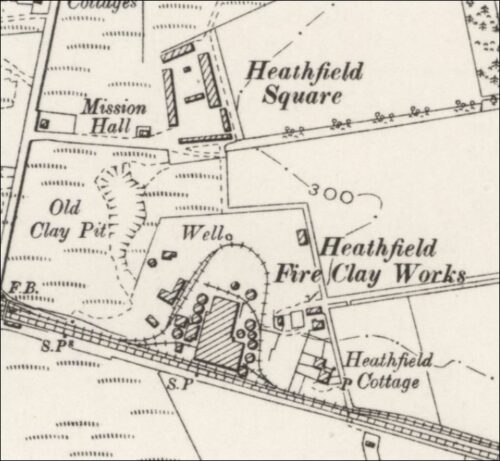
28/11/1900 – The Scotsman – Lanarkshire miners grievances … A special meeting of the Executive Committee of the Lanarkshire County Union was held in the Union offices at Hamilton last night, Mr R . Smillie presiding … They also reported that they had discussed the points of difference at the Heathfield Fireclay Pit with the owners and that there was a probability of a settlement being effected …
13/03/1901 – Kirkintilloch Herald – Miners strike. The fire clay miners employed by Messrs Dunnachie at Glenboig and Gartcosh; Messrs Hurll at Gartliston; and Mr Phaill (Faill?) at Heathfield, Garnkirk have come out. The men some time ago made a demand for an increase of 4d per ton. This the masters refused to grant. The fireclay miners then joined the Lanarkshire Miners County Union, and negotiations were commenced on behalf of the men by Mr Gilmour. On Saturday the demand was modified to an increase of 1 1/2d per ton. Almost simultaneously with this, the masters posted up a notice of a reduction of a penny per ton, with the result that Mr Gilmour has brought the miners out. The number of miners engaged at Glenboig, Gartcosh, Gartliston and Heathfield number about 250. The effect of the strike is likely to throw all the brickworks at these places idle soon as the present surplus stock of fire clay is used up and will consequently cause a very large number of men employed as moulders, burners, etc., to be idle.
20/03/1901 – Kirkintilloch Herald – Wanted. Miners to keep away from Glenboig, Gartliston, Gartcosh and Heathfield Fireclay Pits during the present dispute.
11/07/1901 – Dundee Courier – The Glenboig Evictions – Dundee men to fill places. On Wednesday the miners resident at Heathfield, who have been out on strike, were evicted in a very quiet manner. Mr Robertson, of Messrs Brownlee & Robertson, Sheriff Officers, West Nine Street., Glasgow, arrived at Heathfield and, proceeding to the Square, served warrants on Thomas Goodman, Terrance M. Creanor, local secretary of the Miners Union; Wm. Jardine, Wm. McKeown, John O’Bryne, and James Divine. There was no appearance of any organised resistance, the houses in most instances being open, though in two cases the doors had to be smashed open with sledgehammers. Superintendent Cook and a force of police were present, but their duties were so light. Mr Graeme Hunter was also present and aided by the works manager, pointed out the respective houses to Mr Robertson. A new feature in the dispute is the fact that Mr Hunter has secured all the houses of the convicted parties. Those already secured have been furnished, and the men employed by him are lodged. The houses at Heathfield will be furnished later. The supply of labour at Glenboig, Garnqueen, Gartliston, Gartcosh, and Heathfield is to be regulated by Mr Hunter for a period of three years, and contracts between the parties have already been signed. A number of workers are expected from Dundee.
31/12/1902 – Kirkintilloch Herald – The Heathfield Fire Clay Workers were agreeably surprised on hearing that the works would only be closed for 3 days. (Christmas break?)
1907 – Heathfield and Cardowan Fire Clay Co, 52 Robertson Street and 241 Glebe Street, St Rollox.
05/06/1907 – Kirkintilloch Herald – Workers excursion. The employees of the Heathfield and Cardowan Fire Clay Coy. held their annual holiday on Saturday last, when they journeyed to Rothesay to spend a few hours in that beautiful little watering-place, which has deservedly earned the name of the “Brighton of Scotland.” The company, which numbered nearly 300, left Garnkirk Station at 7.40, comfortably seated in a special train of beautiful carriages. Notwithstanding the unfavourable nature of the weather, everyone was in the best of moods, which foretold a day of pleasure in spite of any opposing forces. All went well on the way to Gourock. which was reached at 09.30, just half an hour late. The “Duchess of Hamilton ” was patiently waiting but ere. many minutes had passed the gangways were drawn and full speed ahead was the order of the day. The steamer was well filled, as there were other two parties on board, many of whom were of Polish nationality and whose employment is now amongst the “black diamonds” of Lanarkshire. It being “ special,” the boat made direct for Rothesay and although the weather was cold and dull, the hour’s sailing was pleasantly spent in walking, dancing, and in listening to the well-known strains of the Chryston Brass Band under the leadership of Mr Henry Letham. It was just 10.35 when Rothesav was reached. The day remained cold and threatening, but with very little rain so that there was no great hardship in being out-of-doors, and many of the principal sights were visited and explored. Large numbers travelled to Ettrick Bay in the electric cars and the journey was a most enjoyable one. The sands, however, were not seen to advantage for lack of sunshine. Sixt o’clock was the hour for returning and about twenty minutes to the hour the “Duchess of Hamilton” again made her appearance. When the clock struck six, the beautiful Caledonian steamer began to move, and Rothesay was soon left far behind. The homeward journey was a most expeditious one and Garnkirk was reached at 8.50 p.m., all thoroughly satisfied with their day’s outing …
22/12/1909 – Kirkintilloch Herald – Betrayed by a light. About ten o’clock on Friday night last, Mr Thomas Nicoll, son the manager Heathfield Works belonging to the Heathfield & Cardowan Fireclay Coy., was standing at the door of his house, when he observed a light in the engineering shop of the works. Knowing that no light should have been there, he called his father and brother, and the trio on arriving at the place were just in time to detain two men who were leaving the premises carrying a large bag. Constables Nicoll and Grubb were afterwards called and on examining the bag it was found to contain about one and a half cwts. of brass, which had been stripped from the engines. The two men were taken to the Police Station at Muirhead, where they gave their names as John Watson, labourer and David Craig, fireman, both having no fixed place of abode. On Saturday morning they were brought before the Sheriff at Glasgow and remanded for a week.
Below –
1910 – Heathfield Fire Clay Works.
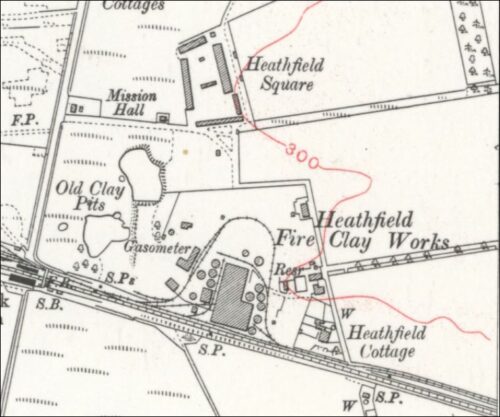
22/07/1910 – Milngavie and Bearsden Herald – Alleged malicious damage. In the Justice of the Peace Court at Lanarkshire at Glasgow on Thursday, 14 inst, Justices Cleland and Macleod on the bench, Owen Callaghan, George McCall and Francis Reilly, all residing in Muirhead, Chryston appeared in answer to a complaint under the Summary Jurisdiction (Scotland) Act 1908 at the instance of Thomas Cleland Macgregor, Procurator Fiscal charging them with having on 26th June 1910, within Heathfield Brickworks, Muirhead, Parish of Cadder, and County of Lanark maliciously damaged twelve fireclay retorts, and trampled upon and destroyed 2oo bricks. The three accused pleaded not guilty, and were defended by Mr Archibald Hamilton, solicitor, Glasgow and Muirhead. George Nicol, works manager, J. McIlroy and Patrick Marshall, watchmen, and Constable Nicol and Grubb gave evidence for the prosecution. The case for the prosecution, however, broke down under cross-examination, and the bench, after hearing the evidence of Callaghan and McCall, and without calling upon Reilly, found the charge against all of them not proven.
Below –
10/03/1911 – Milngavie and Bearsden Herald – Heathfield and Cardowan Fireclay Company agree to pipe clean water to their worker’s homes, albeit somewhat reluctantly!
03/05/1911 – Kirkintilloch Herald – Heathfield & Cardowan Fireclay Company Ltd agree to lay a 3″water pipe to Heathfield Square providing the District Committee lay the pipe from the main in Garnkirk Road to the boundary of their feu.
06/03/1912 – Kirkintilloch Gazette – Miners strike … The strike is having a serious effect on the other industries of the district, work having been suspended at the Heathfield and Cardowan Fire Clay Coy Ltd, Heathfield; The Glenboig Union Fireclay Coy Ltd at Gartcosh, Glenboig and Cumbernauld and Messrs P & M Hurll’s Ltd, Glenboig.
05/04/1912 – Milngavie and Bearsden Herald – … Mr Robert Allan, under manager, Heathfield Fire Clay Pit …
24/04/1912 – Kirkintilloch – Meeting of the North and South Cadder Special Water Districts. A comprehensive article about the lack of domestic water at the houses owned by the Heathfield and Cardowan Fireclay Co Ltd at their employee houses at Heathfield Square and the occupied houses on the disused Cardowan Fire Clay Works site.
1913 – The Cardowan Works were abandoned by 1913 but the Heathfield site was expanded and came under the control of the Grierson family who continued to make pipes until 1968 under the company name of Heathfield and Cardowan Fireclay Company Limited and the Heathfield and Cardowan Pipeworks Ltd – Source Kenneth Sanderson.
20/09/1915 – Dundee Courier – A fire in Glasgow causes £4000 worth of damage to various businesses including … 52 Robertson Street, Glasgow occupied by the Heathfield and Cardowan Fireclay Co limited, suffered damage by fire and water.
31/07/1917 – The Scotsman – Deaths. At Glasgow on 29th inst, John Faill of the Heathfield and Cardowan Fireclay Co Ltd, 3rd son of Peter Salmon Faill, 8 Glenorchy Terrace, Edinburgh.
08/09/1920 – Kirkintilloch Herald – At the meeting of Cadder Water Committee a report by the engineers was submitted on a claim by the trustees of the late John Jeffray of Cardowan and Heathfield for wayleave and damages in connection with the laying of water pipes in Cardowan and Heathfield, and stating that as far as the Heathfield claim was concerned the road in which the pipe was laid was subject to a right of access by the Heathfield and Cardowan Fireclay Company who are feuars of ground for their works and for their workmen’s houses. After consideration, the Committee remitted the matter to Mr Warren to adjust with the trustees’ valuer, on the lines indicated in the report, and on which lines Mr Warren was authorised to settle but otherwise to report to the Committee.
01/04/1925 – Kirkintilloch Gazette – On Thursday fire was discovered to have broken out in the mill room at Heathfield Brickworks, belonging to the Heathfield and Cardowan Fireclay Co. The fire brigade was summoned from Bishopbriggs, and on their arrival, there was a little difficulty with regard to the water supply, which was surmounted. The efforts of the brigade were mainly directed to prevent the fire from spreading to other parts of the works, and in this they were successful. Occurring as it did in the evening, the fire was witnessed by a large crowd, and the spectacular scene as viewed from the station was something to be remembered. The damage is estimated at £2000.
15/08/1930 – Kirkintilloch Gazette – The death of George Nicholl who had previously worked for 50 years at the Heathfield and Cardowan Fireclay Company Ltd as an engineer and works manager.
10/04/1931 – Milngavie and Bearsden Herald – Refund wanted. Minutes of Finance Committee stated that the Heathfield and Cardowan Fireclay Coy Ltd. had applied for refund of water assessment on the ground of double assessment in the years 1928-29 and 1930-31. After explanations had been given, the application was not entertained.
25/06/1932 – Airdrie and Coatbridge Advertiser – Garnkirk. Moss fire. A fire broke out at Heathfield Moss on Tuesday. Bishopbriggs Fire Brigade were summoned and succeeded in preventing the flames from spreading to Heathfield Brickwork and the LMS Station at Garnkirk …
Below – 1935 – Heathfield Fire Clay Works.

13/02/1935 – Kirkintilloch. Renewal of gas plant. At the meeting of the Gas Committee, it was agreed to recommend that there should be a renewal of a retort setting at an estimated cost of £108 and that the building should be done by Mr R. S. Workman, Saltcoats as previously; and that the material required procured from the Heathfield and Cardowan Fire Brick Company Limited. It was agreed that this recommendation should be reported to the Finance Committee at their next meeting. The Finance Committee agreed to the expenditure.
03/12/1949 – Airdrie and Coatbridge Advertiser – Early years of brickmaking … It is not accurately known when the clay was first found at Glenboig nor is it known just when bricks were first made there. The industry goes back as far as 1834 if not further. Certainly, in 1894 John Hillcoat was engaged in brickmaking. He could not have made a great deal of progress because, as late as 1860, the total population was only 130. By this time some information was beginning to be obtained about the clay seams which, being named the Glenboig series of clays, have probably perpetuated the name of Glenboig in geological circles at least. About 1860 signs of the greatness to come were beginning to be seen when a new company, Thomson, McLean Company, acquired the right to work the minerals and were producing bricks on a much larger scale. Meanwhile, Messrs Hurll, Young & Co. were developing the industry at Heathfield and Cardowan (the Glenboig clays are visible in Cardowan pit, by the way), and in 1865 this firm took over from Thomson, McLean & Co. at Glenboig and was probably the first well-known Scottish firm of firebrick makers. This firm carried on till 1874 when, on dissolving the partnership, Mr John Hurll acquired the Glenboig Works while Mr Young went back to the Heathfield and Cardowan Works. As a member of the technical department of the present-day highly controlled mass-producing plant, I can read into these records of mixed fortune stories of high endeavour and bitter disappointment because the Glenboig minerals were never simple or straightforward, and even today, one hundred and twenty years after, we realise how much we do not know of the intriguing substance, fireclay …
Below – 1956 – 1964 – Heathfield Fire Clay Works.
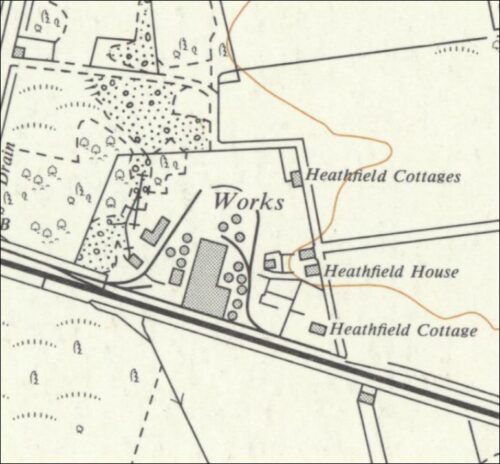
08/02/1963 – Wishaw Press – Ravenscraig keeps kilns busy. The new strip mill at Ravenscraig has been a blow against unemployment in Scotland – and not only among the ranks of the steelworkers. Two Scottish members of the National Salt Glazed Pipe Manufacturers Association have supplied many tons of fireclay pipes and fittings to the scheme. The pipes from four inches diameter upwards have been used in main and ancillary drainage networks. For the past five years Messrs Loudon and Russell Ltd of Morningside and the Heathfield and Cardowan Fireclay Co Limited, the two members, have been supplying fireclay pipe to the Ravenscraig Works. This has ensured full and continuous employment in both firms. Says Mr George Loudon, managing director of Loudon and Russell “During this time we have not only avoided laying off our people, but we have also taken on extra labour, and kept it”
1968 – The Heathfield and Cardowan Pipeworks Ltd was bought by United Fireclay Products Limited – Source Kenneth Sanderson.
(The 1985 publication ‘A survey of Scottish brickmarks’ suggests that the works were possibly operated by United Collieries from 1911 – c.1947 and from c.1947 – c. 1965 by United Fireclay Products?).
*************************
July 1961 – Mr George Cleland Awarded M.B.E. Mr George Cleland, works manager of Heathfield and Cardowan Fireclay Co Ltd. Of Chryston, near Glasgow, was awarded the M.B.E. in this year’s Queens Birthday Honours List. Mr Cleland. who is 81 years of age has been with Heathfield and Cardowan for 66 years and is retiring in September of this year. He started works in the office of the firm’s Cardowan works in December 1894 and was transferred to the Heathfield works about a year later. He was appointed an assistant manager in 1910 and has been works manager since 1925. During his sixty-six years with Heathfield and Cardowan, Mr Cleland has seen many changes in methods of production and many changes in conditions and wages. In the 1890s bricks were all handmade, an average day’s work being 3,000 x 3 in. squares for a 10 1/4 hour day. Hours of work were from 6.15 a.m till 1 p.m. An average week’s wage for a moulder was about 25s. In those days too, all salt-glazed pipes were handmade faucets. Mr Cleland has always been confident that salt-glazed fireclay pipes would be preferred to concrete, even for the larger sizes and has been proud of the fact that Heathfield and Cardowan have always made all sizes up to 24in. diameter. The award of M.B.E. is an honour of which Mr Cleland is very proud and is an honour which he feels that he shares with the industry, the firm, and the workers with whom he has been associated over the last sixty-six years.
Below – some images of salt-glazed pipes still in situ at the Heathfield Fire Clay Works.

.

.

.

.
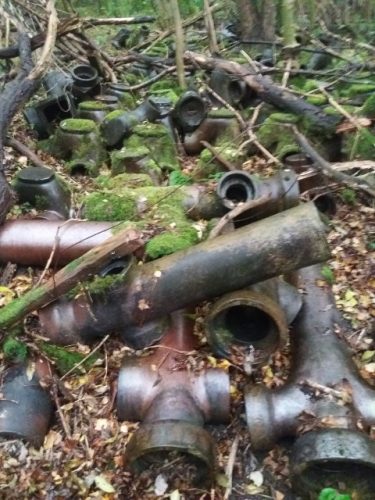
.

.

.

.

.

Below – A metal gully cover at Station House, Muirhead marked Heathfield & Cardowan.

and another found by Eddie Mclean in the Glasgow area.

Below – An unmarked, glazed block. These were found at the Heathfield Fireclay Works and many had been cemented together. It was undoubtedly made on site.
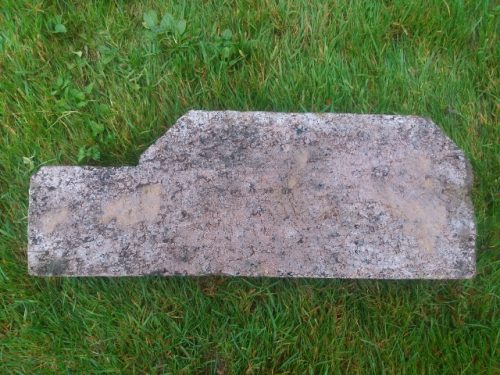
Below – An unmarked salt-glazed saddle joint found at the Heathfield Fire Clay Works.

.

Below – Unmarked wall coping found on site.

.








































